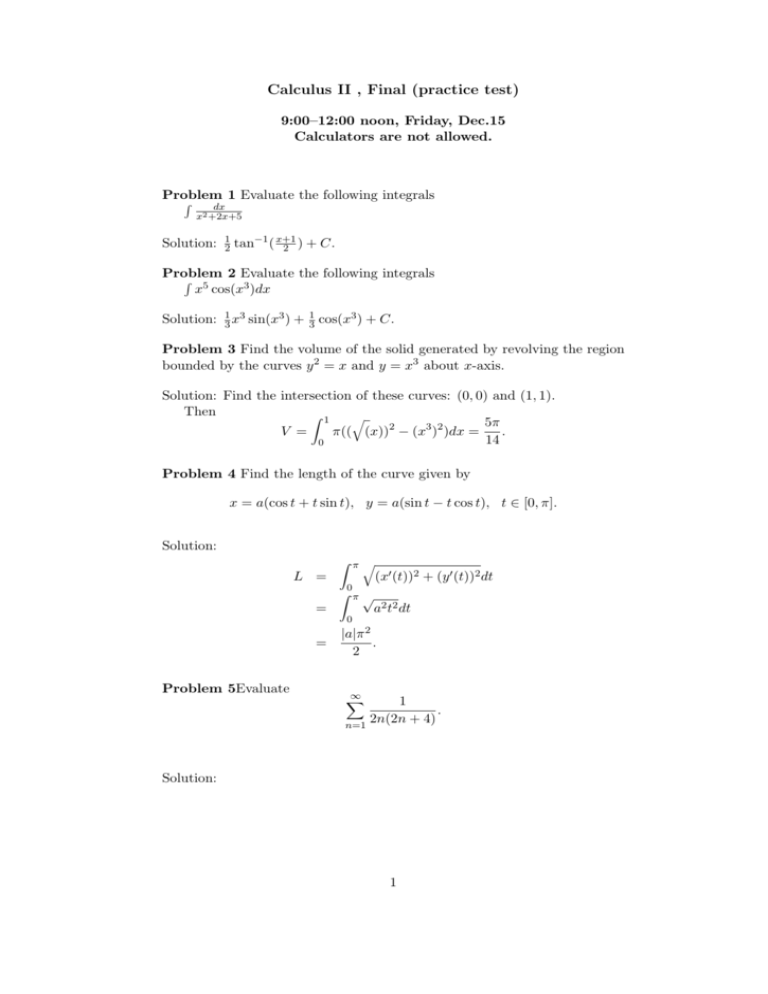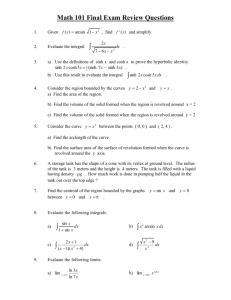Calculus II , Final (practice test)
advertisement

Calculus II , Final (practice test) 9:00–12:00 noon, Friday, Dec.15 Calculators are not allowed. Problem 1 Evaluate the following integrals R dx x2 +2x+5 Solution: 1 2 tan−1 ( x+1 2 ) + C. Problem 2 Evaluate the following integrals R 5 x cos(x3 )dx Solution: 1 3 3 3 x sin(x ) + 13 cos(x3 ) + C. Problem 3 Find the volume of the solid generated by revolving the region bounded by the curves y 2 = x and y = x3 about x-axis. Solution: Find the intersection of these curves: (0, 0) and (1, 1). Then Z 1 q 5π V = π(( (x))2 − (x3 )2 )dx = . 14 0 Problem 4 Find the length of the curve given by x = a(cos t + t sin t), y = a(sin t − t cos t), t ∈ [0, π]. Solution: Z π q π √ L = 0 Z (x0 (t))2 + (y 0 (t))2 dt = a2 t2 dt 0 = Problem 5Evaluate |a|π 2 . 2 ∞ X 1 . 2n(2n + 4) n=1 Solution: 1 ∞ X 1 2n(2n + 4) n=1 = = = ∞ 1 1 1X ( − ) 8 n=1 n n + 2 1 (1 − 1/3 + 1/2 − 1/4 + 1/3 − 1/5 + 1/4 − 1/6 + 1/5 − 1/7 + ...) 8 1 (1 + 1/2) = 3/16. 8 Problem 6 Decide the convergence or divergence of ∞ X nn n=1 n! . Solution: Apply the ratio test, an+1 n + 1 nn + 1 1 =( ) = (1 + )n → e > 1. an n n+1 n Therefore it diverges. x −x Problem 7Let sinh x = e −e . Find its power series at 0 along with its 2 convergence interval. Show that sinh x is equal to its power series. x n+1 −x Solution: (sinh)(n) x = e +(−1)2 e . So (sinh)(n) (0) = 1 if n is odd and (sinh)(n) (0) = 0 if n is even. Therefore formerly the Taylor expansion of sinh x is ∞ X x2n+1 . (2n + 1)! n=0 2n+1 y Rn+1 (x) = (2n+1)! → 0 for some y between 0 and x. Therefore sinh x is equal to its power series. Problem 8 Find ex − 1 − x . x→0 x sin x lim Solution: ex − 1 − x 1 + x + x2 /2 + ... − 1 − x = lim = 1/2. x→0 x→0 x sin x x2 lim Problem 9 Which value for p > 0 makes X sin( n=1 2 1 ) np convergent? Prove it. Solution: Apply the limit comparison test for P and n=1 n1p . The answer is p > 1. 1 1 n=1 sin( np ) P Problem 10 Find the Taylor Polynomial for f (x) = e− x2 at x = 0, where f (0) is defined to be 0. Solution: 0. 3











